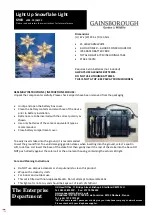
Programming Manual UTG1000X Series
Instruments.uni-trend.com
9
/
51
CHANnel Command
It used to set the channel function of the signal source.
:CHANnel<n>:MODE
Syntax
:CHANnel<n>:MODE {CONTinue|MODulation|SWEep|BURSt }
:CHANnel<n>:MODE?
Description
Set the signal mode for the specified channel, which is CONTinue, MODulation, SWEep or BURSt.
<n>: Channel number, n takes value 1, 2.
Return Format
The query returns the signal mode of the specified channel.
For Example
:CHANnel1:MODE MODulation
Set signal mode of CH1 to MODulation.
:CHANnel1:MODE?
The query returns MODulation.
:CHANnel<n>:OUTPut
Syntax
:CHANnel<n>:OUTPut {{1 | ON} | {0 | OFF}}
:CHANnel<n>:OUTPut?
Description
Turn on/off the channel output switch of the specified channel.
<n>: Channel number, n takes value 1, 2.
Return Format
The query returns the output status of the specified channel. 0 represents OFF, 1 represents ON.
For Example
:CHANnel1:OUTPut ON
Turn on CH1 output.
:CHANnel1:OUTPut?
The query returns 1.
:CHANnel<n>:PA:OUTPut
Syntax
:CHANnel<n>:PA:OUTPut {{1 | ON} | {0 | OFF}}
:CHANnel<n>:PA:OUTPut?
Description
Turn on/off power amplifier output.
<n>
:
Channel number, n takes value 2.
Notice
:
This function can only enabled when it has power amplifier module. Normal CH2 and power amplifier
output are mutually exclusive, and normal CH2 cannot be used at this time.
Return Format
The query returns the status of power amplifier output. 0 represents OFF, 1 represents ON.
For Example
:CHANnel2:PA:OUTPut ON
Turn on power amplifier output.










































